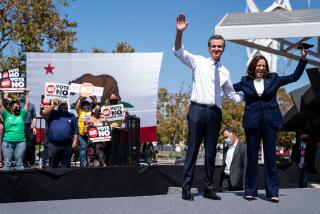Changing TV Viewers’ Political Diet
- Share via
Paul Taylor once gorged himself on politics. It made him sick.
For 12 years as a political writer, the last eight at the Washington Post, he had an upfront seat on history. He even made a bit himself. It was Taylor, during the passion play of the 1988 presidential primary, who asked Gary Hart in front of God and country whether he had ever committed adultery. Political discourse has never been the same.
Two years ago, Taylor left the reporting dodge to champion a more altruistic cause: improving the quality (read: substance) of political coverage. “Somebody said elections are the feast of democracy,” Taylor observed, but “in the modern era, in the television era, what elections pump out is junk food. And if you feed the public junk food again and again and again, they don’t get much nourished by it, they don’t like it after a while, and when the election rolls around they say, ‘I’m outta here.’ ”
So with some grant money, a fancy letterhead and the burning conviction of a convert to cause, Taylor is trying to change America’s political diet, one local television station at a time. Where better to start than California, original home of the empty calorie election?
*
It’s easy to criticize the way most California television stations cover (or, more accurately, don’t cover) politics. Perhaps too easy. By now, the notion of freeway chases and Hollywood fluff crowding out Serious Coverage of Public Affairs (which viewers, of course, prefer) has become something of its own media cliche. As if “Access Hollywood” loses half its audience each time C-SPAN goes live to the Senate floor.
Still, the fact is most people turn to television as their primary source of information, and when it comes to political coverage, with apologies to Gertrude Stein, there’s rarely any there there.
Enter Taylor, bearing the banner of his nonpartisan Alliance for Better Campaigns. His mission: convince TV stations in 10 states, including biggies Texas, Florida, Illinois and California, to devote five minutes to substantive political coverage each Sunday night for eight weeks, from Labor Day until the November election.
Not free air time for candidates to blab at will, a proposal Taylor pitched to the major networks in 1996 with little success. Rather, he suggests five minutes in which local stations would bring their state’s gubernatorial candidates together in a structured series of mini-debates, jazzed up with the flashiest techno-wizardry the best brains in TV can muster.
“They have the tools, they know what their medium is about,” Taylor says. “For whatever reason, they have devoted dazzling technology, creativity and energy to turn the weather into an eight-minute saga every night. Now, weather is pretty important stuff and we need to know whether it’s going to rain or not. But we don’t need to go for eight minutes.”
Instead, imagine TV stations spending just five minutes each Sunday night trying to clear the fog, instead of merely talking about it.
*
The notion, with apologies to Kevin Costner, is simple: Build it and they will come. For years, some of the great minds (and many not so great) have wrestled with a chicken-egg riddle over the reason so many local TV stations cover politics so poorly. Is it for lack of an audience? Or is the audience lacking because the coverage is so poor?
Taylor says forget all the noodling. Try putting something on the air that people want to see. Then stand back, he says with utmost confidence, and watch the crowds come.
“There is an audience for political news out there,” agrees Dan Schnur, one of California’s craftiest political strategists and a consultant to Taylor’s group. But to attract that audience requires some consistency, some assurance of the same-time, same-station nature.
“If you have to channel surf between seven stations looking for a little bit of political news, it’s tough to do,” says Schnur. “But if you know there’s going to be a political exchange on a specific station on a specific day at a specific time every week, you’re going to tune in and so are a lot of other people.”
Or so it is hoped. In California, gubernatorial wannabes Gray Davis and Dan Lungren--already planning five full-scale debates--have indicated a willingness to show up on successive Sundays for eight more petite pairings. So far, Taylor has gotten commitments from two major California TV stations, KGTV in San Diego and KCBS in Los Angeles, to broadcast those smaller sessions. Talks are continuing with outlets in Sacramento and San Francisco.
Although the format details remain to be worked out, “I don’t envision a lot of bells and whistles, or politicians flying through the air,” said KGTV’s Lee Swanson. “It’s going to straight-on question and answer.”
The experiment--and that’s what Taylor calls it--could flop. Candidates might filibuster. Viewers might flee. But Taylor doesn’t think so.
Besides, what do local stations have to lose by trying except, perhaps, their carping critics?
More to Read
Get the L.A. Times Politics newsletter
Deeply reported insights into legislation, politics and policy from Sacramento, Washington and beyond. In your inbox twice per week.
You may occasionally receive promotional content from the Los Angeles Times.











